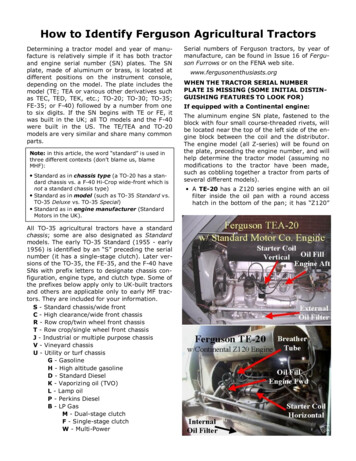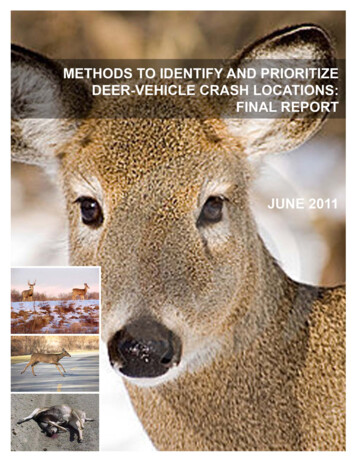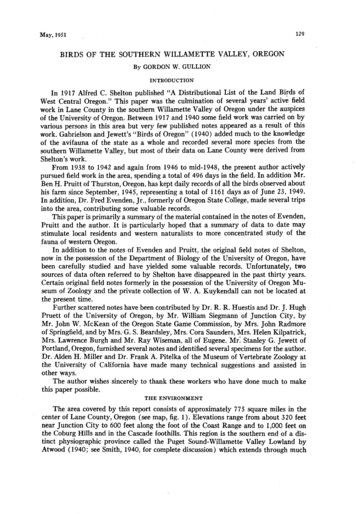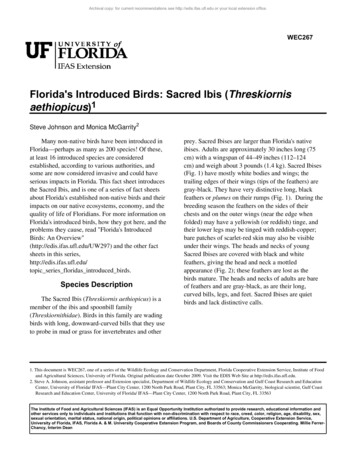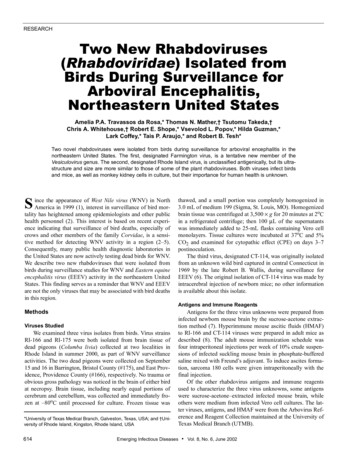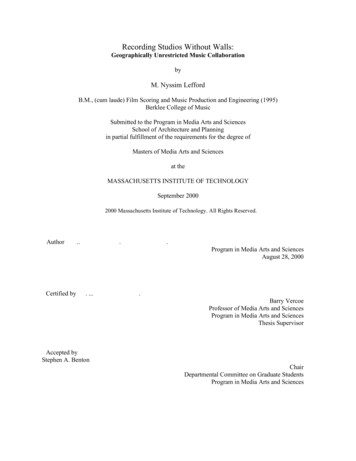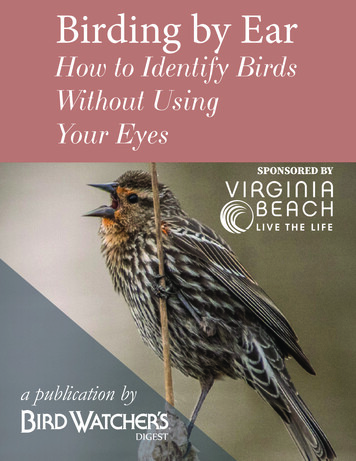
Transcription
Birding by EarHow to Identify BirdsWithout UsingYour EyesSPONSORED BY
AYefugeCWKildBlife RBioAnalNatWE HAVE THE SPACE,DISCOVERYOUR NEW PLACE.Thousands of acres of city and state parks.Hundreds of miles of inland waters. Over300 species of birds. Your new secret spotis here, just waiting to be discovered.visitvirginiabeach.com
There is a lot more to bird watching thanjust watching.When you rely solely on your eyes while birding, you pass over tiny kinglets and creepers and reclusive wrens and towhees. With your ears “turned on,” you can hear so many more birds chipping, buzzing, trilling, and singing. Most birds, especially in a woodland setting, are heard beforethey’re seen. If you’re not engaging your auditory sense, you may be missing more than half thebirds around you!You don’t need to be an avid birder to notice that birds make a wide variety of sounds. Some ofthese sounds are gentle and pleasant, like the beautiful phrasing of a newly arrived wood thrushin spring. Other sounds can be jarring and annoying—at least to a nonbirder—such as a northern mockingbird’s mechanical imitations on a summer night.But why do they do it? Birds are not singing and squawking for our enjoyment (or annoyance).Songbirds vocalize to communicate. Their sounds can be divided into two main categories:songs and calls.A bird’s song is the more musical, complicated sound. In most species only the male sings, andhe’s singing for two primary reasons: to attract a female and to warn other males to keep offhis turf. Birdsong is related directly to courtship, breeding, and territoriality; this is why we hearbirds singing in spring and summer, and not so much in fall and winter. Some species will singfrom a hidden place in a thicket, but most male birds seek a prominent perch from which toproclaim their songs. Some males sing around the clock during breeding season. It’s those springhormones that are mostly to blame for your neighborhood mockingbird’s nocturnal concerts.A bird’s call is usually a short chip, whistle, trill, twitter, or chirp. This is how birds communicate in an everyday sense. Males and females, adults and immature birds call throughout the year.Birds use calls to keep contact among the members of a flock or family group, to warn off predators, to signal food, and in a variety of other ways.Compared with songs, bird calls can be somewhat harder to learn, as calls are less musical,shorter, and generally less memorable than songs. But mastering bird calls is possible, and, withpractice, can greatly enhance your ability to find and identify birds.Some bird species rely on non-vocal sounds to communicate their courtship and territorialmessages. Examples of non-vocal bird sounds include woodcocks and mourning doves with whistling wings, and woodpeckers drumming on hollow trees.To recap:Songs attract mates or defend territoryCalls may be chip notes, or scolding, or chatter, or mobbingNon-vocal sounds include the wing whirs of mourning doves or hummingbirds, or thebooming of grouse on leksLearning to listen to birds takes patience and practice. It may seem an impossible task, but it’snot as difficult as you might think. In fact, you likely already know several bird vocalizations:American robin, mourning dove, northern cardinal, American crow, mallard, Canada goose, killdeer, and wild turkey, just to name a few. The key to mastering birdsong identification is to startwith the birds you already know—the species most commonly heard in your backyard or neighborhood—and then slowly add new songs and calls to your vocabulary.
CDs, apps, or websites with recordings of birds are helpful and useful, but these do not substitute for the real birds outside your window. Make a point of watching a bird as it sings—theaudio-visual connection will stick in your mind. Some people use mnemonics to help them remember specific songs. The eastern towhee’s “Drink your TEA!” or the barred owl’s “Who cooksfor you all?” are common examples.Over time, with practice, you will recognize bird vocalizations nearly subconsciously, as youwould recognize a familiar singer’s voice on the radio or a family member’s laugh in the otherroom. Soon you will step outside and know those sweet, musical phrases as robins singing, thosesquealing keeyah keeyahs as courting red-shouldered hawks, those potato-chip twitters as goldfinches passing overheard, and that bright, clear whistle as a newly arrived Baltimore oriole.As many a birder can attest, a whole new world opens up when we become aware of the incredible diversity of birdlife that shares our space. We hope this guide will get you well on yourway to identifying birds solely by sound.Prothonotary warblerzweet zweet zweetRemember: A vocalizing bird is telling youwhat it is as well as where it is.Always listen for bird sounds, even if you can’t identify every chip note or other sound. Thinkabout how to describe what you hear.How to learn: Practice makes perfect!Practice in the field: Make audio-visual connections and, if possible, take an expert with youPractice at home: Watch videos and listen to recordingsPractice committing songs to memory: Do whatever helps you remember; take notes of whatyou hearPractice learning mnemonics: Sometimes there are words to describe bird sounds, like cheep,tweet, twitter, hiss, and squawkPractice by focusing on a familiar species: Pick one you are likely to hear a lot, then study it untilyou know every nuance
Let’s make a vocabularyRhythm: Pattern, tempo, trillPitch: High, low, mid-range, ascending then descendingTone: Squawk, whistle, musical, scratchy, rough, flutelikeParts: Three-part song, repeated song, or something else?Complexity: Is it super-simple or really complex?Speed: Rapid, slow, partly trilled, simple trending to complex, slow then fastBlack-throated green warblerzee zee zee zee zo zeeDescriptive ExamplesTrilling: chipping sparrowBuzzy: scarlet tanager or blue-winged warblerStaccato: hairy woodpeckerFlutelike: wood thrushOperatic: rose-breasted grosbeak or BaltimoreorioleWhistled: northern bobwhiteInsect-like: grasshopper sparrowMonotonous: prothonotary warblerRepeated: brown thrasherSing-song: American robinFast: house wrenAscending: prairie warblerSlow: yellow-throated vireoDescending: yellow-throated warblerComplex: bobolinkCrescendo (gets louder): ovenbirdSimple: tufted titmouseTwo-toned or three toned: black-cappedchickadee,Emphatic: Acadian flycatcherHigh-pitched: Blackburnian warblerTwo distinct parts: Nashville warbler (Tenneseewarbler has three parts)Low-pitched: common raven
American robincheer-up cheer-a-lee cheer-ee-oPopular MnemonicsAcadian Flycatcherpeet-seet or peet-suh or peetAmerican Goldfinchpa-chip-chip-chip per-chick-a-reepo-ta-to-chip (and dip when in flight)American Redstarttzee-tzee-tzee-tzeeeoAmerican Robincheer-up; cheer-a-lee; cheer-ee-o, whinnyBaltimore Orioleflute-like; disjointed series of noteshere; here; come right here; dearBarred Owlwho-cooks-for-you; who-cooks-for-you-allBlack-throated Blue WarblerI am so lazzzyPlease please please squeezeBlack & White Warblerwee-zee; wee-zee; wee-zee (like a squeaky wheel)Blue leBlue-gray Gnatcatcherzpeee (a bit raspy)Blue-winged Warblerbeee-bzzz; blue winged! (second syllable buzzy)Brown Thrashervaried mocker-like phrases (repeated 2x)drop-it; drop-it; cover-it-up;cover-it-up; pull-it-up; pull-it-upBrown-headed Cowbirdbubble-bubble-zeeee!Carolina Wrenbrrrrrrr (a brief; downslurred; rapid trill like thumbingcomb tines)chooble-dee (varied triplet phrases)tea-kettle; tea-kettle; tea-kettleCedar Waxwingzeee-zeee-zeee (rapid, high-pitched trill, always in flocks)
Cerulean Warblerchyoo-chyoo-chyoo-tseee (last syllable burry)trill (ending with buzzy) beeeeChipping Sparrowchipping trill (mechanical)Common Yellowthroatwitchety-witchety-witchety (slow)tchep (flat and raspy)Hooded Warblerweeta-weeta-weet-tee-oIndigo Buntingvaried phrases (in couplets)fire; fire; where? where? here; here; see it? see it?Kentucky Warblerp’chee; p’chee; p’cheeDowny Woodpeckerpeeek (sharply) whinnyLouisiana Waterthrushchiptree; tree; tree terwitter-witter witEastern Phoebefee-beee (last syllable raspy)Northern Cardinalcheer-cheer-cheer-purty-purty-purtyEastern Towheetoo-wheee! drink-your-teeeee!hot dog; pickle-ickle-icklecherwinkNorthern huflicker flicker flicker!Eastern Wood Peweepee-a-weee and pee-yerField Sparrowa ping-pong ball dropped onto a tableincreasing in rateNorthern Mockingbirdvaried phrases (repeated thrice or more)Northern Parula Warblertrill! (fast rising; ending with)-tsyoozeeeeeeeeeeeeeee(buzzy)-chyooHairy Woodpeckerpik (flat) whinnyBlack-throated blue warblerI am so lazzzy
Ovenbirdp’cheer - p’cheer - p’cheerteacher teacher teacher!Prairie Warblerzee-zee-zee-zee (steady rise in pitch)Prothonotary Warblerzweet; zweet; zweet (single pitch)Red-bellied Woodpeckerchurrr; churrr (throaty; deeply trilled)Red-eyed Vireowhere are you? and here I amRed-headed Woodpeckersqueer; squeer (raspy)Red-shouldered Hawkkee-yer; kee-yer; kee-yerRed-winged Blackbirdchortle-deeeeeeconk-a-reeeeeeeeetseer; tseerScarlet Tanagercheer-up; cheer-a-lee; cheer-ee-o (burry; raspy)chick-burrr (last syllable rapidly trilled)hurry; worry; blurry; flurry (burry)Song tle-ettleHip; hip; hip hurrah boys; spring is here!Madge; Madge; Madge pick beetles off; the water’s hotStarlingwolf-whistle (breathy)Summer Tanagercheer-up; cheer-a-lee (bouncy, musical)piky-tucky-tuck or pik-a-tuckRed-tailed HawkkeeeeeeeeerRed-winged blackbirdconk-a-reeeeeeeee(A female red-winged blackbirdappears on this e-book’s cover.)
Song le-ettleTufted Titmousecheeva; cheeva; cheeva fer-da; fer-da; fer-dahere; here; here peter-peter-peterWarbling VireoIf I sees you I will seize you and I’ll squeeze you till yousquirt (to a caterpillar)brigadier; brigadier; briga-teeWhite-breasted Nuthatchanh-anh-anh-anh o-who-whoWhite-eyed Vireochick; per-wee-tee-o; chick or chick-per-wee-oQuick give me a rain checkChick Corea ChickWood Thrushchk-chk-chk (dry-subtle)ra-vi-o-li (flute-like)ee-oh-lay (flute-like, last note trilly)oo-duh-lay-oh or oodle-drrrr (last note trilly)fweet-fweet-fweet (rapid-fire)Worm-eating Warblertrill (very rapid, even, mechanical)Yellow Warblersweet; sweet; sweet; little-more-sweetYellow-billed Cuckoohoo-luh; hoo-luh; hoo-luh (1/sec; broken)ka-ka-ka kowp-kowp-kowpYellow-breasted Chatwhoit (whistled)wit; wit; wit or chak; chak; chakYellow-throated Vireothree-Ay; three-AyYellow-throated Warblertsyoo-tsyoo-tsyoo-tsyoo -tswee
Yellow warblersweet sweet sweet littlemore-sweetWant More Great Content like this?If you enjoyed this publication, Bird Watcher’s Digestis for you.greatEvery bimonthlyissue of Bird Watcher’sWant morebirdingOne Year/Six IssuesDigest delivers useful advice andcontent?OneYear/Six Issueshelpful information, in addition99If you liked this publication, you’ll enjoy Bird Watcher’s99 captivatingphotographsandDigest. Everytobimonthlyissue ofNorth America’sfirstOhio residents add 7.25% sales taxmagazine dedicatedsolely tobirding delivers bird watchcompellingstories. 19.19.ing tips, robust species profiles, compelling stories ofbirding adventures, and captivating photographs fromprofessional bird photographers.Ohio residents add7.25% sales tax.EasierBird ID: Gull ID Just Gotember 2017Vol. 40 No. 2, November/DecBIRD WATCHER’S DIGESTSpecies ProfileGolden EagleID SparrowsIGEST’S D. 3,January/FebrFar AfieldLake Erie’s:North Shoreuary2016We really’t know!NOVEMBER/DECEMBERPhotograUsing a camphy:as binocu eralarsDisplay until December 31stJAN2017TraBurr E JAYPRIL 2016Y2FC.MARCH/ARYJF164, March/AprilWHAT DOBIRDS EAT?donFarHo AfieMa g Isla ld:ine nd,Far AfieldBirding in Belizein the Buff!Vol. 38 No.IdentifyCormorants!Vol.38 NoDIGESTHERBIRD arn toDisplay until February29thTo order, call 1-800-879-2473or visitTObirdwatchersdigest.comORDER: call11/18/15Species Profile:WilsonPhalaro’speMA16 FC.inddDisplay untilApril 30th11/19/162:31 PM1-800-879-247312:50 PM2016
WE HAVE THE SPACE,DISCOVERYOUR NEW PLACE.Fifteen hiking and biking trails through anunmatched coastal landscape on six milesof unspoiled beach. Your new secret spotis here, just waiting to be discovered.visitvirginiabeach.com
Without Using Your Eyes SPONSORED BY. DISCOVER YOUR NEW PLACE. WE HAVE THE SPACE, visitvirginiabeach.com Thousands of acres of city and state parks. Hundreds of miles of inland waters. Over 300 species of birds. Your new secret spot is here, just waiting to be discovered. BA CK BA Y National W e. When you rely solely on your eyes while birding, you pass over tiny kinglets and
